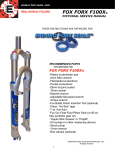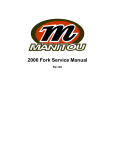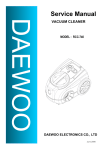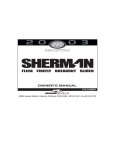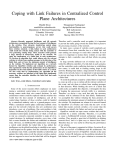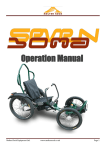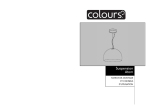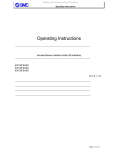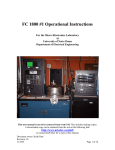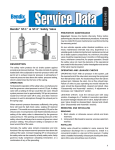Download MANITOU MINUTE 1:00® ENDURO FORK SEALS™
Transcript
NOTE: THIS WEB VERSION IS BEST VIEWED AT “75%” IN YOUR ADOBE READER WINDOW PICTORIAL SERVICE INSTRUCTIONS for the MANITOU MINUTE 1:00® EnduroForkSeals.com ©2005 EnduroForkSeals.com/Real World Cycling All rights reserved. THESE INSTRUCTIONS ARE OPTIMIZED FOR ENDURO FORK SEALS™ RECOMMENDED PARTS FOR SERVICING THE MANITOU MINUTE 1:00® -Plastic bucket/drain pan -2mm and 8mm Allen wrenches -7/16” wrench -Flat-bladed screwdriver -Pocket screwdriver -24mm (15/16”) socket -16mm (5/8”) socket -Ratchet wrench -Adjustable flat-jawed wrench -Torque wrench -Clean “lint-free” rags -5 wt. fork fluid -Heavy Synthetic Grease -“Super-Slick Grease” or “PrepM” -Oil syringe (or other measuring device) -Shock pump 1 MANITOU MINUTE 1:00® ©2005 EnduroForkSeals.com/Real World Cycling. All rights reserved. 1) Adjust the travel to its longest setting (fully extended). Note the indicator on the back of the fork crown. 2) Remove the Schraeder valve cap from the SPV side and carefully relieve the air pressure. Be prepared for a small amount of oil to spray out with the air. 2 MANITOU MINUTE 1:00® ©2005 EnduroForkSeals.com/Real World Cycling. All rights reserved. 3) Adjust the rebound knob mid-way and use the 2mm Allen wrench to remove the retaining screw. Pull the rebound knob straight down to remove it. 4) Invert the fork and use the 8mm Allen wrench to wind the damper rod CLOCKWISE into the lower leg. Please note the inset and remember that the rod threads up INTO the lower casting. Do not try and wind it out, or damage will result. 3 MANITOU MINUTE 1:00® ©2005 EnduroForkSeals.com/Real World Cycling. All rights reserved. 5) On the spring side (rider’s left), use a 7/16” wrench to remove the bottom fixing bolt. This bolt backs out CCW, unlike the damper rod. Manitou recommends an 11mm wrench, but the bolt on this fork, was slightly too big and required a 7/16”. HAVE A BUCKET READY BEFORE THE NEXT STEP! 6) OVER A BUCKET OR OIL PAN, turn the fork back over, drain the semi-bath oil out of the lower assembly, and pull the lower assembly off of the stanchions. There are only 16cc’s of oil in each lower leg, so you can just pull the lowers off while the oil is draining if you wish. 4 MANITOU MINUTE 1:00® ©2005 EnduroForkSeals.com/Real World Cycling. All rights reserved. 7) After draining the oil, invert the lower assembly to remove the bottom washers. (You never know what you might find inside your fork....) 8) Remove the garter springs from the top of the wipers. Removal of the garter spring is not really necessary, but, if left in place it just ends up getting smashed and in the way. 5 MANITOU MINUTE 1:00® ©2005 EnduroForkSeals.com/Real World Cycling. All rights reserved. 9) Insert a flat-bladed screwdriver under the back end of the seal/wiper. Note that the shaft of the screwdriver is wrapped in tape to protect the finish of the fork. 10) Apply downward pressure on the screwdriver handle until the wiper/seal “pops” up and out. Be careful not to scratch the metal at the back of the lowers while prying up the old wipers. 11) Remove the “foam ring” from the seal insertion area. The foam rings will not be re-used. They will be replaced with a special “inner oil seal.” REPEAT STEPS 9-11 FOR THE OTHER SIDE. 6 MANITOU MINUTE 1:00® ©2005 EnduroForkSeals.com/Real World Cycling. All rights reserved. 12) If the lowers are particularly dirty, it’s time to move to the sink and use some biodegradable degreaser. Sometimes the semi-bath lube turns to “jelly” and needs to be cleaned out. 13) Chase the degreaser with a mixture of hot water and dish soap and a little brushing, if needed. RINSE well with hot water. Using hot water not only cuts the grease, but heats up the lowers and causes them to dry quicker due to evaporations. 7 MANITOU MINUTE 1:00® ©2005 EnduroForkSeals.com/Real World Cycling. All rights reserved. 14) Thoroughly dry the lower legs. 15) This is the BOTTOM of the inner oil seal. See the deep groove? IT FACES DOWN. 16) This is the TOP of the inner oil seal. See the word “ENDURO?” IT FACES UP. 8 MANITOU MINUTE 1:00® ©2005 EnduroForkSeals.com/Real World Cycling. All rights reserved. 17) Use some Super-Slick Grease®, Prep-M® or other supsension compatible grease to lubricate the outside edge of the inner oil seal and the seal-insertion area of the lowers. 18) Start the seal into the lower leg and use your thumbs to press it down evenly until flush with the top edge of the lower leg. 19) Use a large inverted socket and extention to carefully seat the inner oil seals in each leg. Push very lightly, slowly increasing pressure until the seal begins to move. Once it starts sliding, it takes very little pressure to seat it against the bushing. 9 MANITOU MINUTE 1:00® ©2005 EnduroForkSeals.com/Real World Cycling. All rights reserved. 20) This is the Enduro Wiper. Apply a thin coating of grease to the insertion area of the wiper. 21) Start the wiper into the insertion area of the lower leg. It should be easy to start, as the leading edge is slightly tapered. If the wiper goes in easily enough, you may seat it by hand and skip Step 22. If you can’t start the wiper by hand, try putting the wipers in a freezer for 10 minutes. This will cause the inner metal band to contract, thus slightly reducing the OD of the wiper insertion area. 10 MANITOU MINUTE 1:00® ©2005 EnduroForkSeals.com/Real World Cycling. All rights reserved. 22) Use a piece of 1-1/4” PVC pipe to press the wipers in until no gap can be seen below the wiper “lip.” You are now finished servicing the lowers, and are ready to service the damping leg. (If you are not planning to service the damper leg, you may proceed to step 41). 23) This is the SPV top cap assembly. It’s shown here with the red chamber volume adjuster nut backed all the way out (meaning the chamber has maximum volume). For ease of removal, it is recommended to have the adjuster nut in this position. 11 MANITOU MINUTE 1:00® ©2005 EnduroForkSeals.com/Real World Cycling. All rights reserved. 24) Use a 5/8” or 16mm socket on the red adjuster hex back out the entire SPV top cap. Because the top cap is only tightened at 25-35 inch pounds, you can use the adjusting hex to back out the cap without being concerned about putting too much stress on it. (Using a 24mm socket on the larger black hex will work, but the red hex tends to remain fixed, with the rest of the top cap rotating around it. This results in the volume adjuster being fully extended into the top cap body. For some reason the top cap is more difficult to pull out with the volume adjuster wound in.) 25) Remove the SPV top cap. Note that with the volume adjuster backed out for maximum volume in the chamber, the lower O-ring is just beyond the threads of the black top cap body. 12 MANITOU MINUTE 1:00® ©2005 EnduroForkSeals.com/Real World Cycling. All rights reserved. This is what the top cap assembly looks like with the adjuster hex wound all the way IN. This is how volume is reduced in the air chamber. 26) Pour the damping oil out of the chamber. Slowly pumping the damping rod will help to get most of the oil out. 27) Use good-quality adjustable flat jawed pliers or a wrench to loosen the damper end cap. It would be nice if thicker wrench “flats” were provided .... You will have to be careful to get a good grip so the wrench does not slip off. 13 MANITOU MINUTE 1:00® ©2005 EnduroForkSeals.com/Real World Cycling. All rights reserved. 28) Remove the SPV/rebound assembly from the stanchion. The assembly picture on the left has the 2004 SPV valve, as evidenced by the Oring. The assembly pictured on the right is the 2005 SPV Evolve®, which has a flat, Teflon® seal in place of the O-ring. The new design requires less force to initiate movement (the new seal has less stiction than the O-ring). Internally, the previously solid check valve disc now has an orifice, so that oil movement is never completely shut down. 29) Verify a gap of approximately 1mm between the blue SPV valve and the black piston. 14 MANITOU MINUTE 1:00® ©2005 EnduroForkSeals.com/Real World Cycling. All rights reserved. 30) Test the responsiveness of the SPV valve. Use your fingers to compress the blue SPV valve against the black damping piston. The valve should spring back to the open position when you release it. Check the condition of the O-ring at the bottom of the rod. If it is torn or deformed, replace it. 15 MANITOU MINUTE 1:00® ©2005 EnduroForkSeals.com/Real World Cycling. All rights reserved. 31) Apply a light coating of a suspension-friendly grease such as Super-Slick Grease® or PrepM® on the O-ring or Teflon® seal (depending on whether you are using the SPV or the SPV Evolve cartridge). 32) Likewise, lightly coat the threads at the end of the right stanchion tube. 16 MANITOU MINUTE 1:00® ©2005 EnduroForkSeals.com/Real World Cycling. All rights reserved. 33) CAREFULLY insert the SPV/rebound damper assembly into the stanchion tube. Don’t try and shove the assembly past the threads or you will damage the seal. Wind the damper assembly clockwise and “thread” the seal past the threads. 34) Use good-quality adjustable flat jawed pliers or a wrench to tighten the damper end cap. The recommended torque for the plastic end caps is 25-35 inch pounds. Unless you have a properly sized (24mm) “crows foot” open end wrench attachment for your torque wrench, just carefully “snug” the end cap. 17 MANITOU MINUTE 1:00® ©2005 EnduroForkSeals.com/Real World Cycling. All rights reserved. 35) Slowly add about 60cc of 5 wt. synthetic suspension fluid into the top of the damper leg (we like Maxima® Fork Fluid). After adding the fork fluid, cover the top opening with a clean towel, and work the damper rod up and down several times to be sure that suspension fluid ends up below the piston. 36) Repeat step 35 so that the total suspension fluid added is about 120cc. 18 MANITOU MINUTE 1:00® ©2005 EnduroForkSeals.com/Real World Cycling. All rights reserved. 37) Verify the correct suspension fluid height. A simple method for accomplishing this is to use an oil syringe and a piece of plastic tubing. Since the longest travel setting of this fork is 130mm, an oil height measurement of 84mm (3.3 inches) is correct (early versions of the factory .PDF service manual said “3.9in, 75mm”--bad math!). Starting from the bottom of the syringe body, measure 84mm out onto the plastic tubing, mark and cut. Insert the syringe and tubing into the fork leg until the syringe body is resting against the crown. Remove it and look for fluid on the end of the tubing. If the tubing did not contact fluid, add fluid until it is higher than the end of the tube. Re-insert the syringe with the plunger fully compressed into the syringe body. Holding the syringe against the crown, pull the plunger up, removing the excess oil until only air is being pulled into the syringe. You are now at a level of 84mm. 19 MANITOU MINUTE 1:00® ©2005 EnduroForkSeals.com/Real World Cycling. All rights reserved. 38) Lightly lubricate the threads and both O-rings on the SPV top cap. Use Super-Slick Grease® or Prep-M®. 39) Start the top cap into the top of the leg by hand. 40) Torque the top cap to 35-50 inch pounds. Use a 24mm socket on the outer (black) hex of the SPV top cap. 20 MANITOU MINUTE 1:00® ©2005 EnduroForkSeals.com/Real World Cycling. All rights reserved. 41) Pressurized the SPV air chamber to about 40 PSI. This helps to keep the damper rod extended during re-assembly. You are now finished servicing the damping leg and are ready to service the spring stack. (If you are not planning to service the spring stack, you may proceed to Step 55). 42) Use a 2mm Allen wrench to loosen the adjuster knob set screw. 21 MANITOU MINUTE 1:00® ©2005 EnduroForkSeals.com/Real World Cycling. All rights reserved. 43) Lift the adjuster knob straight up and off of the top cap assembly. Be sure and put these small parts in a safe place, laid out in the order in which they were removed. 44) Remove the O-ring from around the travel scale. 22 MANITOU MINUTE 1:00® ©2005 EnduroForkSeals.com/Real World Cycling. All rights reserved. 45) Loosen the Travel Wind Down top cap using good-quality adjustable flat jawed pliers or a wrench. The factory manual recommends a 28mm socket, but there is not really enough room for a socket to fit between the crown recess 46) Remove the top cap and coil spring. The spring assembly usually comes out with the top cap even though it is just a friction fit (The “D”-shaped protrusion at the end of the top cap pushes into the “D”shaped end of the main spring). If the spring wants to stay in the leg, it may be due to the fact that some early production models had a spring retaining washer on top of the Wind Down Compression Rod assembly. If this is the case with your fork, the spring will come out when you remove the Wind Down Compression Rod. 23 MANITOU MINUTE 1:00® ©2005 EnduroForkSeals.com/Real World Cycling. All rights reserved. This is the stock coil spring with the top cap still in the end of it. Notice the smaller diameter spring interwined in the center of the main spring. This is called the “Booster Spring.” The stock configuration is considered “Medium.” For lighter-weight riders wanting a “Soft Ride Kit,” simply wind the Booster Spring out of the main spring and only re-install the main spring in the fork. The “Firm” and “Extra Firm” ride kits consist of stiffer main springs, respectively. The original Booster Spring is then wound into the new main spring. The spring assembly requires lubrication with a heavy-bodied grease such as Pedro’s Syn Grease® (NOT Prep-M®). 24 MANITOU MINUTE 1:00® ©2005 EnduroForkSeals.com/Real World Cycling. All rights reserved. 47) Loosen the Wind Down Compression Rod End Cap. Use good-quality flat-jawed adjustable pliers or an adjustable wrench. 48) Remove the Travel Wind Down Compression Rod assembly from the stanchion tube. If you have one of the early production forks that did not allow the main spring to be removed from the top of the leg, the main spring will now come out with the assembly. It is recommended that you perform the following modification so that the main spring can be removed from the top during future service: 1) Separate the compression rod from the spring by simultaneously pulling them apart while bending them at a slight angle to each other. 2) Remove the Allen bolt from the top of the compression rod, lift off the nylon washer, and re-install the Allen bolt. 25 MANITOU MINUTE 1:00® ©2005 EnduroForkSeals.com/Real World Cycling. All rights reserved. If you followed the directions and dis-asssembled your fork with the travel in the longest setting, then the Wind Down Compression Rod looks like this. When the fork is assemble and you adjust the Travel Wind Down Knob, the “D”shaped main spring end drives the black spacer up and down the Wind Down Compression Rod. 49) Re-install the Wind Down Compression Rod and tighten the end cap. Be sure everything above the end cap is clean and properly lubed with a heavy-bodied synthetic grease. 26 MANITOU MINUTE 1:00® ©2005 EnduroForkSeals.com/Real World Cycling. All rights reserved. 50) Re-install the main spring: (Be sure the main spring assembly is clean and well-lubed with a heavy-bodied synthetic grease.) Slide the Wind Down Compression Rod up about half way into the stanchion tube and hold it there. Slide the main spring down into the fork leg until it contacts the top of the Compression Rod assembly. Slowly rotate the spring until the the “D”-shaped spring end aligns with the “D”-shaped top of the Compression Rod assembly (you will feel the spring drop into place). Continue to use the Compression Rod to hold the spring up. 27 MANITOU MINUTE 1:00® ©2005 EnduroForkSeals.com/Real World Cycling. All rights reserved. 51) Re-install the Wind Down top cap into the main spring. Be sure the O-ring and threads have a light coating of suspension grease on them. Remember to line up the “D”- shaped spring end with the “D”-shaped protrusion on the bottom of the end cap. Use the Compression rod to slowly lower the spring assembly into place and start the top cap threads by hand. 52) Tighten the Wind Down top cap. The recommended torque for the top cap is 35-50 inch pounds. Unless you have a properly sized (28mm) “crows foot” open end wrench attachment for your torque wrench, just carefully “snug” the end cap. 28 MANITOU MINUTE 1:00® ©2005 EnduroForkSeals.com/Real World Cycling. All rights reserved. 53) Replace the O-ring around the travel scale. 54) Replace the Adjuster Knob and use a 2mm Allen wrench to tighten the set screw. 29 MANITOU MINUTE 1:00® ©2005 EnduroForkSeals.com/Real World Cycling. All rights reserved. 55) Prepare to put the upper and lower assemblies together. -Invert the “Crown/Steer/Leg” assembly. -Extend the rods fully, sliding the rubber bumpers down against the end caps. -Place the washers (removed from the lower legs in Step 7) on top of the bumpers, as pictured. -Lubricate the inside of the new seals and wipers with Super-Slick Grease®. -Lubricate the O-ring and threads at the bottom of the damper rod. 56) Start the lowers over the rods and down to the stanchion tubes. Be sure the reverse arch is facing the right way. When the wipers reach the end caps, carefully work one wiper over the cap and just onto the stanchion; then work the other wiper on to its stanchion. 30 MANITOU MINUTE 1:00® ©2005 EnduroForkSeals.com/Real World Cycling. All rights reserved. 57) Slide the lowers down about half way onto the stanchions (if you push them all the way on, there will be no space to inject the semi-bath oil into). Reposition the fork horizontally, with the end of the lower assembly angled slightly upward. 58) Inject about 16cc of semibath oil into each lower leg. Manitou recommends Motorex® SemiBath 5/40w synthetic oil. Other brands are available, but can be difficult to find in this weight. Maxima® 15wt Fork Fluid seems to work very well (this is not a recommendation as it has not been tested in all conditions). 31 MANITOU MINUTE 1:00® ©2005 EnduroForkSeals.com/Real World Cycling. All rights reserved. 59) Cover the lower casting holes with a clean towel to prevent oil from being ejected and push the lower assembly all the way onto the stanchions. Be sure the SPV/Rebound damping rod is pressed against the bottom of the lower leg casting. 60) Use the 8mm Allen wrench to wind the SPV/Rebound damper rod back into the lower leg casting. Turn counter-clockwise as indicated in the inset picture. Proper torque value is 10-30 inch pounds. 32 MANITOU MINUTE 1:00® ©2005 EnduroForkSeals.com/Real World Cycling. All rights reserved. 61) Carefully line up the Rebound Adjuster Knob and push it up into the bottom of the damper rod. 62) Insert and tighten the Rebound Knob set screw, using a 2mm Allen wrench. Hold the knob to keep it from rotating while tightening the screw. 63) Insert and tighten the Compression Rod Fixing Bolt. Inspect the O-ring and replace it if torn or distorted. Lubricate the O-ring and threads with Super-Slick Grease® or Prep-M®. Recommended torque: 10-30 inch pounds. 33 MANITOU MINUTE 1:00® ©2005 EnduroForkSeals.com/Real World Cycling. All rights reserved. 64) Make initial pre-ride adjustments. -Start with the SPV volume adjuster (red hex) backed all the way out. -Pressurize the SPV chamber to 30 PSI. (This is the minimum.) -Adjust the “sag” (in this case, probably 30% of travel). Have someone support the bike while you sit on it in normal riding position, wearing your full riding gear (including hydraton pac, water bottles, etc.). Use a cable tie or similar means to see how far into the travel the bike settles. If you don’t have enough sag, pull the main spring back out of the left leg and remove the inner booster spring (see Steps 42-54). If you have too much sag, you will need to order a “Firm” or “Extra Firm” spring and wind your existing booster spring into it. -Set the rebound knob to the half way point. 34 MANITOU MINUTE 1:00® ©2005 EnduroForkSeals.com/Real World Cycling. All rights reserved. HEAD TO THE TRAIL FOR FURTHER ADJUSTMENTS--TAKE YOUR SUSPENSION PUMP WITH YOU. -Dial in the “rebound.” If the fork is extending too harshly or you feel the fork is tending to “pogo” off of bumps, increase the rebound damping. If your fork is tending to “pack up” (following a series of bumps, your fork ends up too compressed to absorb subsequent impacts), decrease the rebound damping. -Adjust the SPV pressure. If you just want more of a “platform” (want a bigger hit required to activate full travel) you need to add air pressure at the SPV topcap. This will take some experimentation and depends on personal preference. It will be a trade off--you can’t have the perfect platform for hammering out of the saddle and still have supple small-bump sensitivity when seated. -Adjust the SPV chamber volume. If you find the damping too linear (you blow through the travel and tend to bottom out (presuming you have the sag/spring rate set correctly) you can turn the volume adjuster of the SPV valve inward to reduce the volume of the chamber. This will cause the fork to be more “progressive, or “ramp up” sooner and resist bottoming out. DETAIL OF PHOTO BY “DGC” ©2004 ALL RIGHTS RESERVED These are adjustment guidelines. It will take time and experimentation to really “dial-in” your fork. 35 MANITOU MINUTE 1:00® ©2005 EnduroForkSeals.com/Real World Cycling. All rights reserved. PROPER CARE OF YOUR ENDURO FORK SEALS™ Stanchion Lube™ by Finish Line® For longevity, it is important to keep the stanchion tubes and top edges of the wipers clean. (Note the dust ring on top of the wiper.) Use a soft, clean cloth to carefully clean the stanchion tubes and wipers. Drizzle some Stanchion Lube™ onto the clean stanchion tubes and allow it so settle on the tops of the wipers. Compress the fork a few times. Using a soft cloth, work the excess Stanchion Lube™ into the upper legs. Repeat until no residue remains. 36




































